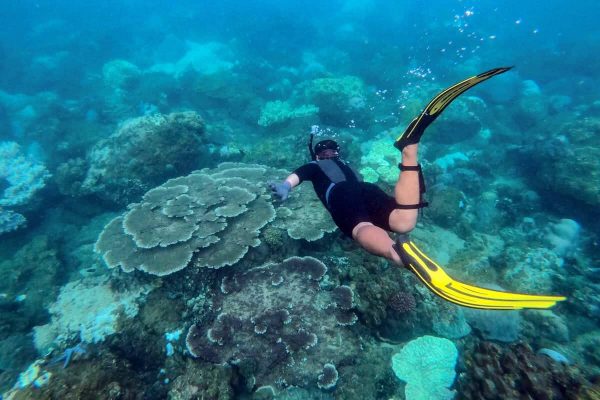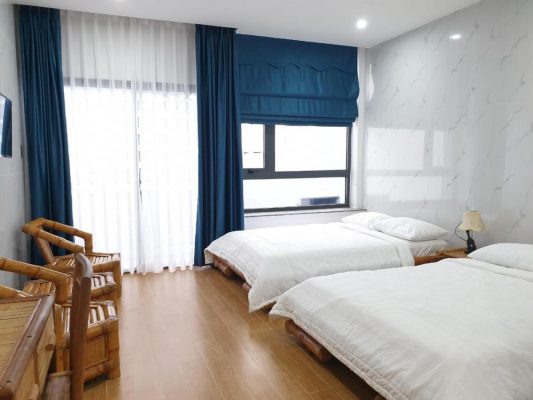
Son Tra Peninsula
Explore the pristine beauty of the Son Tra Peninsula! Discover its historical significance, breathtaking landscapes, and diverse wildlife. Plan your adventure with Ula Travel’s guide to must-visit spots like Linh Ung Pagoda and Ban Co Peak. Enjoy thrilling activities such as snorkeling, hiking, and wildlife observation. Find everything you need for an unforgettable trip to the Son Tra Peninsula.
I. Overview of the Son Tra Peninsula
1. Where is Son Tra Peninsula?
Son Tra Peninsula is located in the coastal city of Da Nang. It juts out into the South China Sea, forming a natural shield that protects the city from storms and cyclones. Covering an area of about 60 square kilometers, the peninsula is approximately 10 kilometers from the city center, making it easily accessible for visitors.
2. Special Things about Son Tra Peninsula

Son Tra is the green lung of Da Nang
Son Tra Peninsula, often referred to as the “Green Lung” of Da Nang, is a haven for nature lovers and adventure seekers. Its rich biodiversity includes over 1,000 plant species and hundreds of animal species, including the endangered red-shanked douc langur. The peninsula’s pristine beaches, lush forests, and scenic mountain views make it a popular destination for both relaxation and outdoor activities.
3. Cultural Significance of the Son Tra Peninsula
Son Tra’s cultural landscape is enriched by its connection to local folklore and traditions, making it not just a scenic destination but also a repository of Vietnam’s cultural identity. Whether exploring ancient temples, participating in traditional rituals, or simply admiring the local architecture, visitors to the Son Tra Peninsula are invited to delve into its rich cultural tapestry, fostering a deeper appreciation for Vietnam’s heritage and spiritual legacy.
II. Things to See on the Son Tra Peninsula
1. Linh Ung Pagoda

Linh Ung Pagoda
Linh Ung Pagoda, perched on the stunning Son Tra Peninsula, is one of the largest and most significant pagodas in Da Nang. This magnificent structure blends modern and traditional Vietnamese architectural styles, characterized by intricate carvings, elegant statues, and a serene atmosphere.
- Main Hall: The central hall is adorned with beautiful carvings and statues of various Buddhas and Bodhisattvas. The main Buddha statue, surrounded by meticulously detailed guardian deities, is a sight to behold.
- Guan Yin Statue: The pagoda is famously home to the tallest statue of the Goddess of Mercy (Guan Yin) in Vietnam, standing at 67 meters. This statue is not only a religious symbol but also an architectural marvel, attracting pilgrims and tourists alike.
One of the highlights of visiting Linh Ung Pagoda is the breathtaking panoramic view it offers. Situated at an altitude of approximately 700 meters, the pagoda provides an unparalleled vantage point over Da Nang City and the surrounding areas.
Are you looking for: Da Nang tours
2. Ban Co Peak (Chessboard Peak)

Ban Co Peak
Ban Co Peak, also known as Chessboard Peak, is one of the most spectacular destinations on the Son Tra Peninsula. It offers breathtaking panoramic views and a variety of activities for nature enthusiasts and adventurers alike.
- 360-Degree View: From the summit of Ban Co Peak, visitors can enjoy a 360-degree view of Da Nang City, the East Sea, and the lush green forests of the Son Tra Peninsula. The view is especially stunning at sunrise and sunset, when the sky is painted in vibrant colors.
- The Legend of Ban Co Peak: Ban Co Peak gets its name from a local legend involving two deities playing chess on the mountain. According to the tale, the game was so intense that it lasted for days. The stone chessboard, which can still be seen at the peak, symbolizes this ancient game and adds a mystical allure to the location.
- Hiking and Trekking: There are several trails leading up to Ban Co Peak, ranging from easy to moderately challenging. Hikers can enjoy the journey through lush forests, with chances to spot local wildlife and rare plant species.
Do not miss: Da Nang to Hue – Unexpected Trip You’ll Love
3. Thousand-Year-Old Banyan Tree

Thousand-Year-Old Banyan Tree
One of the most iconic attractions on the Son Tra Peninsula is the Thousand-Year-Old Banyan Tree. This ancient tree, believed to be over a thousand years old, stands as a testament to the region’s rich ecological heritage and cultural significance. Located in a serene and verdant setting, the Thousand-Year-Old Banyan Tree offers visitors a unique glimpse into the area’s natural history and spiritual symbolism.
Visitor Tips:
- Best Time to Visit: Early morning or late afternoon, when the light enhances the tree’s majestic presence.
- Accessibility: accessible via designated paths and trails suitable for walking or gentle hiking.
- Guided Tours: Consider joining guided tours to gain deeper insights into the tree’s history and ecological significance.
4. Beaches in the Son Tra peninsula

Rang Beach
Rang Beach is famous for its crystal-clear waters and vibrant marine life. It is an ideal spot for snorkeling and diving, where you can explore colorful coral reefs and exotic fish. The beach is also perfect for swimming and sunbathing, offering a serene environment with its soft white sand and gentle waves.

But Beach
But Beach, also known as Buddha Beach, is known for its calm, shallow waters, making it suitable for families and beginners in water sports. Kayaking and paddleboarding are popular activities here, allowing visitors to enjoy the scenic views from the water.
Start your journey with: Da Nang to Hoi An in 4 Days
III. Things to Do on the Son Tra Peninsula
1. Scuba Diving and Snorkeling

Scuba diving to see coral reefs
The waters around the Son Tra Peninsula are known for their vibrant coral reefs and diverse marine life. This makes it a perfect spot for both scuba diving and snorkeling enthusiasts. Whether you’re a seasoned diver or a beginner, there are opportunities for everyone to explore the underwater beauty of this region.
Diving Centers and Equipment Rental
- Son Tra Diving Center: This center offers a range of diving courses, from beginner to advanced. Experienced instructors provide safety briefings and guided dives to ensure a safe and enjoyable experience. Equipment rental is also available for those who do not have their own gear.
- EcoDive Da Nang: Focused on eco-friendly diving practices, EcoDive offers tours that highlight the importance of marine conservation. Their guides are knowledgeable about the local ecosystem and provide informative briefings before each dive or snorkeling trip. Equipment rental and underwater photography services are also available.
Safety Tips and Best Practices
- Follow local regulations: Always adhere to local diving and snorkeling regulations to ensure your safety and the protection of marine life.
- Use environmentally friendly sunscreen: Opt for reef-safe sunscreen to prevent harmful chemicals from damaging the coral reefs.
- Respect marine life: Do not touch or disturb the marine creatures. Observing from a distance helps protect both you and the wildlife.
- Stay Hydrated and Sun-Protected: Bring plenty of water, and wear a rash guard or wetsuit to protect against sunburn and jellyfish stings.
Best Time to Dive
- The best time for diving and snorkeling on the Son Tra Peninsula is from May to September, when the sea conditions are calm and visibility is at its best. During these months, the water temperature is also comfortable, making it an ideal time for underwater exploration.
You will be like: Discover Central Vietnam Tour in 6 Days
2. Hiking and Trekking

Hiking and trekking on Son Tra Peninsula
- Monkey Mountain Trail: This moderate trail is approximately 5 kilometers long and offers a mix of paved and unpaved paths. Hikers will be rewarded with panoramic views of the coastline and the city of Da Nang. This trail is suitable for beginners and those with moderate fitness levels.
- Ban Co Peak Trail: This challenging trail leads to the top of Ban Co Peak, the highest point on the Son Tra Peninsula. The hike is about 7 kilometers one way and involves steep inclines and rocky terrain. This trail is recommended for experienced hikers looking for a rigorous workout and breathtaking views from the summit.
- Banyan Tree Trail: A relatively easy trail, around 3 kilometers long, that leads to the ancient Banyan Tree, a significant natural landmark on the peninsula. This trail is suitable for families and casual hikers, providing a serene walk through the lush forest.
- Intermediary Trails: Several intermediary trails connect various points of interest on the peninsula, such as the trek from Linh Ung Pagoda to the Banyan Tree or from Ban Co Peak to different coastal viewpoints. These trails offer a moderate level of difficulty and are perfect for those looking to explore multiple attractions in one hike.
3. Wildlife Watching

See the red-shanked douc langur on Son Tra Peninsula
Endemic Species and Best Times for Observation:
- Red-Shanked Douc Langur: One of the most famous residents of Son Tra Peninsula, the red-shanked douc langur, is an endangered primate species known for its striking appearance. The best time to spot these langurs is early in the morning or late in the afternoon, when they are most active. Visitors can often see them on the treetops along the Monkey Mountain Trail and near the banyan tree.
- Pygmy Slow Loris: This nocturnal primate is elusive but can be spotted during night tours organized by local guides. The pygmy slow loris is known for its slow movements and large, reflective eyes.
- Birdwatching: Son Tra Peninsula is a haven for bird enthusiasts, home to a variety of bird species, including the Crested Serpent Eagle, the Black-Crowned Night Heron, and the Oriental Pied Hornbill. The best time for birdwatching is during the early morning hours. The coastal areas and the forested regions along the hiking trails provide excellent opportunities for sightings.
- Butterflies and Insects: The diverse flora of the Son Tra Peninsula supports a rich population of butterflies and insects. Visitors can observe a variety of colorful butterflies, especially during the spring and early summer months.
- Marine Life: For those interested in marine biology, the coastal waters around the Son Tra Peninsula are home to vibrant coral reefs and various fish species. Snorkeling and diving tours are available, offering a chance to explore the underwater ecosystem.
More details: Central Vietnam Wonders Tour
4. Explore Local Cuisine

Explore Son Tra Penisula cuisine
The Son Tra Peninsula is renowned for its abundant supply of fresh seafood, sourced directly from the surrounding waters. Visitors can enjoy a variety of dishes featuring locally caught fish, crab, shrimp, and shellfish prepared in traditional Vietnamese styles.
Dining experience tips:
- Experience the best of local flavors at seafood markets and waterfront eateries where you can indulge in grilled seafood and regional specialties.
- When dining out, don’t miss specialties like grilled squid, fresh spring, and seafood hotpot. Be adventurous with your choices, and ask locals or restaurant staff for recommendations on what’s freshest and most delicious.
Learn more about: Da Nang cuisine
IV. Where to Stay When Visiting Peninsula
1. Suggested Homestays
Experiencing local culture and finding affordable lodging are key components of staying at a homestay. Here are three recommended homestays on the Son Tra Peninsula:
Tam House Villa Hotel

Tam House Villa Hotel
- Description: A cozy and charming homestay located near the coastline. It offers comfortable rooms with a blend of modern amenities and traditional decor.
- Features: outdoor swimming pool, garden area, and free bicycle rentals.
- Cost: Affordable rates start at $30 per night.
- Local Experience: Guests can enjoy homemade breakfast with local ingredients and interact with friendly hosts who provide insights into local culture and attractions.
Sea Kite Homestay

Sea Kite Homestay
- Description: A homestay that offers a warm and inviting atmosphere, perfect for solo travelers and families alike.
- Features: spacious rooms, a rooftop terrace with sea views, and an in-house restaurant serving local cuisine.
- Cost: Rooms start at $25 per night.
- Local Experience: Hosts organize cooking classes and local tours, allowing guests to immerse themselves in the regional lifestyle and traditions.
Monkey Mountain Retreat

Monkey Mountain Retreat
- Location: Located on the slopes of Monkey Mountain, this retreat offers stunning views of the coastline and lush forests.
- Amenities: Spacious rooms with modern amenities, an outdoor swimming pool, a garden, and a shared lounge area.
- Experience: Ideal for nature lovers, the homestay organizes bird-watching tours, forest hikes, and visits to nearby wildlife sanctuaries.
2. Camping and Eco-Lodging

Experience camping on Son Tra peninsula
For those seeking to stay close to nature, Son Tra Peninsula offers excellent camping and eco-lodging options. These provide a unique experience of living amidst the natural beauty of the area.
Son Tra Camping Beach
- Description: A popular spot for beach camping, offering direct access to the sea and stunning views of the coastline.
- Features: Tents and basic camping facilities are available for rent. There are also BBQ areas and communal spaces.
- Cost: Camping fees start at $10 per person per night.
- Nature Experience: Enjoy activities like beach volleyball, bonfires, and stargazing. The site is perfect for those looking to relax by the beach and enjoy outdoor activities.
Co Beach Ecological Camping Site
- Description: Nestled in a lush green area, this camping site provides a peaceful retreat with beautiful natural surroundings.
- Features: Equipped with eco-friendly tents, clean sanitation facilities, and a small café offering local snacks and drinks.
- Cost: Rates are approximately $15 per person per night.
- Nature Experience: Ideal for nature lovers who want to explore the forest trails, observe wildlife, and enjoy the tranquility of the natural environment.
Treehouse Lodge
- Description: An eco-lodge that offers a unique stay experience in treehouses, providing a bird’s-eye view of the surrounding forest.
- Features: Treehouses are well-furnished with comfortable beds, solar-powered lighting, and private balconies.
- Cost: Prices start at $50 per night.
- Nature Experience: Guests can partake in guided nature walks, birdwatching tours, and evening campfires. The lodge emphasizes sustainable living and environmental conservation.
Click here: Central Vietnam Wonders Tour
V. Travel Tips and Experiences
1. Best Time to Visit the Son Tra Peninsula
Optimal Travel Period:
- The best time to visit the Son Tra Peninsula is from February to August. During this period, the weather is generally warm and dry, making it ideal for outdoor activities and sightseeing.
Seasonal Climate:
- Spring (February–April): Pleasant temperatures ranging from 20°C to 28°C (68°F to 82°F). This is an excellent time for hiking and exploring the natural beauty of the peninsula.
- Summer (May–August): warm to hot temperatures between 25°C and 35°C (77°F to 95°F). Perfect for beach activities, swimming, and snorkeling. However, be prepared for occasional rain showers.
- Autumn (September–November): Temperatures range from 23°C to 30°C (73°F to 86°F). While the weather is still warm, this period marks the start of the rainy season, which may affect travel plans.
- Winter (December–January): cooler temperatures between 18°C and 25°C (64°F to 77°F). This season is less ideal for beach activities but still suitable for other forms of exploration.
2. Cultural Etiquette
- Greetings: A slight bow or a nod of the head is a polite way to greet someone. Handshakes are also common, especially in more urban areas.
- Dress Code: Dress modestly, especially when visiting religious sites such as temples and pagodas. Shoulders and knees should be covered to show respect.
- Dining Etiquette: When using chopsticks, do not stick them upright in a bowl of rice, as this resembles funeral rites.
- Tipping: Tipping is not mandatory but is appreciated. A small tip for good service, around 10%, is customary in restaurants and for taxi drivers.
In conclusion, the Son Tra Peninsula offers a captivating blend of natural beauty, cultural richness, and adventurous activities, making it an ideal destination for travelers seeking a unique experience. Whether you’re drawn to its pristine beaches, lush landscapes, historical sites, or vibrant local cuisine, Son Tra promises unforgettable moments for every visitor. Plan your journey to the Son Tra Peninsula and immerse yourself in its enchanting allure, where every corner reveals a new adventure and a deeper connection with nature and local heritage.
See more: Da Nang travel tips


























